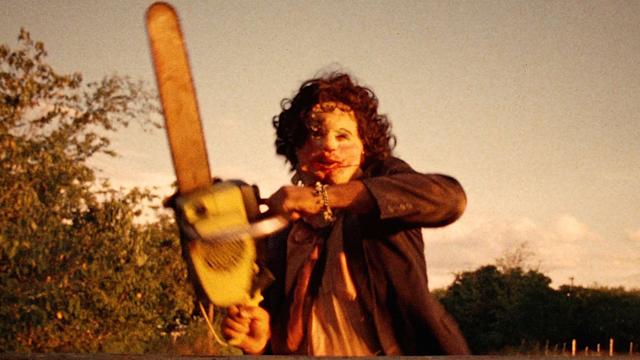Create a free profile to get unlimited access to exclusive videos, sweepstakes, and more!
Every Texas Chainsaw Massacre movie, ranked
Almost 50 years of Texas Chainsaw mayhem, from worst to first.

In 1974, co-writers Tobe Hooper and Kim Henkel came up with a literal nightmare scenario for a movie, centered on a group of Texas teens who run afoul of a family of deranged cannibals. In doing so, they made horror movie history. The Texas Chain Saw Massacre still ranks as one of the scariest and most disturbing genre films of its era, and while its magic has never quite been recaptured, its success led to a franchise that continues to this day.
With the ninth film in the Texas Chainsaw Massacre series now on Netflix, the streamer introduces a new generation of viewers to a killer who's terrorized audiences for nearly five decades. But of course, despite his longevity, not every Leatherface movie is created equal. With films released in every decade since the 1970s, the Texas Chainsaw franchise has had its share of considerable peaks and valleys. This is every Texas Chainsaw movie, including the new installment, ranked.
9. Texas Chainsaw Massacre: The Beginning (2006)
After New Line Cinema and Platinum Dunes scored a hit with a remake of the original film in 2003, it made sense that Texas Chainsaw would continue as a revived franchise. And for the first time in the series' history, we got a prequel exploring how the family now known as the Hewitts got so messed up in the first place.
Sadly, in actual practice, The Beginning is less an exploration of the family madness and more a combination of revenge movie and rehash of the original film, as the Hewitts once again run across a pack of unsuspecting youths to slaughter. There are interesting ideas here, but none of them ever give the series anything truly new.
8. Leatherface (2017)
Another attempt at a Chainsaw prequel, this time helmed by French horror dynamos Julien Maury and Alexandre Bustillo. Leatherface takes the action away from the Sawyer (yes, we're reverting to the original cannibal family name) household and to a mental institution for youths, where the young man who will one day become Leatherface is waiting to transform into his monstrous final form. Featuring some beautiful photography, interesting kills, and an honest effort to deliver something beyond the familiar trappings of the franchise, Leatherface has a certain sense of ambition going for it, and does its level best to paint a sympathetic portrait of the title character. Sadly, it's missing the mayhem that makes the best films in the series so engaging.
7. Leatherface: The Texas Chainsaw Massacre III (1990)
The 1980s brought a lot of changes to the horror cinema landscape, including the rise of the slasher — not just as a popular subgenre, but as a fountain of new horror icons. New Line Cinema, the studio that brought Freddy Krueger to the world years earlier, got their hands on the Chainsaw franchise and decided that Leatherface needed to be the next big horror icon in his own right. So, the third film in the series put his name right up front, gave him plenty of screentime, and even gifted him a sweet stainless weapon with the words "The Saw Is Family" engraved on the blade. While it's a departure from the first two films, Leatherface does manage to deliver a certain level of Texas Chainsaw insanity, backed up by compelling performances from Ken Foree and a young Viggo Mortensen. Sadly, it didn't quite make the slasher icon impression that it set out to deliver.
6. The Texas Chainsaw Massacre (2003)
The 2000s brought a wave of horror remakes both big and small, but even with that climate in mind, an attempt to reimagine the original Texas Chain Saw Massacre felt particularly ambitious.
In the hands of director Marcus Nispel and producer Michael Bay, 2003's The Texas Chainsaw Massacre wisely avoided trying to directly mimic the style and tone of Tobe Hooper's indie classic, and instead gave us a more reverential, deliberately stylized take on the material. Though it's hard to shake the feeling that this film is an unnecessary attempt to cover familiar territory, there are admirable and even clever attempts to remix the original film's plot here. Original Texas Chain Saw cinematographer Daniel Pearl shoots the hell out of Nispel's vision, making vivid and memorable use of the muted tones of early 2000s horror. It's not a great film, but it's still better than you expect it to be, almost 20 years later.
5. Texas Chainsaw Massacre: The Next Generation (1995)
Created by original co-writer Kim Henkel and famously featuring early starring roles for both Matthew McConaughey and Renee Zellweger, Texas Chainsaw Massacre: The Next Generation is a sloppily executed version of what turns out to be a very ambitious concept. It uses the same "youths run afoul of a cannibal family" story that's formed the framework of so many of these films, but it also introduces several other elements that take things in a very interesting direction, including the idea that the family is actually part of a secret society of people who uses violence as a form of transcendence. That, plus McConaughey's scenery-chewing performance and a heavy dose of cross-dressing Leatherface (an underrated and fascinating side to the character) of any film in the series is enough to make The Next Generation watchable, even if it is something of an acquired taste.
4. Texas Chainsaw 3D (2013)
The franchise's first attempt at a requel (yes, there's more than one) casts Leatherface as a hidden remnant of a fallen family, locked away for his own good by a well-meaning relative who also leaves her mansion to a young woman (Alexandra Daddario) with an unlikely connection to the Sawyer clan. The mansion, and the secrets it holds, form the backbone of the film's story even as 3D once again relies on the "well-meaning youths encounter Leatherface" catalyst, and the change of scenery makes for a surprisingly refreshing take on the setup. Then there's the idea of the film's family ties and what they mean, which makes for a compelling and fascinating final act. It's a solid attempt to do something new with the franchise while remaining reverential to the original film, and it all makes for an underrated gem.
3. Texas Chainsaw Massacre (2022)
Director David Blue Garcia's new attempt to requel the Chainsaw franchise, creating a continuity in which none of the sequels took place, mostly succeeds because it sets up a world in which the story can go bigger than its predecessors, and then delivers on all of that promise. Instead of a weird little house in the Texas backcountry, it's an entire weird little ghost town. Instead of a chance encounter gone wrong, it's an unlikely full-on vendetta. Instead of a handful of characters, it's an expansive cast all lined up for Leatherface's favorite power tool. Sometimes it veers into corny territory, and sometimes it takes itself just slightly too seriously, but when it's working, the new Texas Chainsaw is a gnarly dose of all-out mayhem that's wise enough to go its own way with the franchise.
2. The Texas Chainsaw Massacre 2 (1986)
More than a decade after the original film, Texas Chainsaw officially became a franchise with this follow-up from Tobe Hooper himself.
The story of Leatherface and his family encountering everyone from an unsuspecting radio DJ (Caroline Williams) to a chainsaw-wielding lawman (Dennis Hopper) with a vendetta, Texas Chainsaw Massacre 2 starts with one of the wildest death scenes in the history of the franchise, and absolutely never lets up from there. Hooper leans all the way into the dark comedy he flirted with in the original film, and doesn't spare a second of gore, giving us a blood-drenched thrill ride that takes us from backroads all the way to an abandoned amusement park. It's pure, bonkers fun from beginning to end.
1. The Texas Chain Saw Massacre (1974)
Was there ever any doubt that the original is still the best?
Even now, nearly 50 years after it was released, watching The Texas Chain Saw Massacre feels like you're watching a group of people who are legitimately slowly losing their minds together. If you know anything about the history of the film's production, you know that maybe they were.
Produced in punishing Texas heat on a shoestring budget, and filmed in large part in an un-air-conditioned house full of bones and raw meat, Texas Chain Saw is pure seat-of-your-pants madness, held together by Tobe Hooper's uncanny ability to visualize a maelstrom of terror with realism and clever, often understated violence. It's virtually gore-free, but the film's tone is so charged with unhinged menace that it feels like an all-out assault on the senses. It's just as powerful now as it was back then.


























